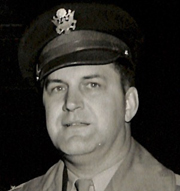Advance W. C. Serviceman To Rank of Full Colonel
A special dispatch to the Freeman-Journal from the headquarters of the Alaska defense command (exact location a military secret) brings news that Lt. Col. Virgil Womeldorff of this city, has been promoted to the rank of colonel.
The promotion was made by Lt. Gen. Simon Boliver Buckner, Jr., commanding the Alaska defense command.
Colonel Womeldorff is a son of Mr. and Mrs. A. E. Womeldorff of this city and his wife is the former Leorra Porter, daughter of Mr. and Mrs. J. D. Porter of this city. The latter and her small son and daughter are staying here at the Porter home, probably for the duration.
Colonel Womeldorff is attached to the engineers, whose duties are about the toughest in the service for they repair roads, dig up mines, build bridges and otherwise make it possible for the army to advance. The colonel is given personal mention in Howard Handleman’s widely read book “Bridge to Victory.” This book is carried in an abridged version in the November issue of the “Readers Digest.”
“Bridge to Victory” is a press correspondent’s story of the combined attack of United States army and navy forces which drove the Japs from the Aleutian island of Attu. Says the “Reader’s Digest,” in introducing the story:
“Weather and terrain combined to make the Aleutians the toughest battlefield in American history. For months our forces under command of the navy but working as a team, patiently built up base after base in the nearer Aleutians, closing in on Kiska and Attu for the short range battle, clearing a skyway to Japan for the long range campaign.
“The showdown came in grim fighting on the barren, treeless section of Attu.”
Source: Daily Freeman Journal, Webster City, IA - Oct. 28, 1943
![]()
Outstanding Army Work Done by W. C .Engineer
Details of outstanding army work by Col. Virgil L. Womeldorff of this city, who won the Legion of Merit award for his services with the engineer corps in the Attu campaign have been furnished the Freeman-Journal by the U. S. engineer department.
The information concerning the colonel, who has returned to his pre-war post as civil engineer with the Illinois Power Co. was cleared for release by the Alaskan department.
Going to Alaska for the Seattle engineer district Mar 11, 1942, as resident engineer and post commander at Cordova, Womeldorff moved to Ladd Field at Fairbanks for the Alaskan department in October, 1942. In April 1943, he was sent to Fort Ord, Calif., to train combat engineer troops for the Attu invasion, returning north in command of the 59th engineer regiment attached to the 7th division for the May 11 attack.
Resident Engineer
Following the battle of Engineer Hill and other Attu victories, he remained as resident engineer in charge of constructing the American base. “Attu is now as comfortable a base as Adak or Shemya, except Attu winters are more severs,” he said.
As the rest of the 7th division moved on to Kajalein and Leyte, Womeldorff went to Adak and then to Shemya in June, 1944, where the 18th engineer regiment had been building two steel-mat runways and a small garrison camp.
“Due to lack of port facilities and a low supply of food and fuel, those troops were pretty badly beaten down far as morale,” he commented.
Womeldorff’s Shemya assignment was to cover completely the two-mile wide, four-mile long island with installations for heavy bombing of Japan. Being flat, Shemya offered a good construction location but maintaining a port in the face of battering Bering sea winds and obtaining an adequate water supply with no mountains or streams were not easy.
Twice the 1500-foot dock, laboriously constructed and so important to the 11th air force supplies, went out in winter storms, but the present sheet-steel piling barge dock, especially designed by the Seattle army engineers, will probably stand up, Womeldorff believes. The water problem has been solved by saving rain water and by wells with filtration plants for surface water.
Has 3 Runways
Shemya now has three asphalt paved runways and hardstandings for parking B-29s. “Eleventh air force units and a navy privateer group kept Shemya pretty busy before V-J day,” Womeldorff remarked.
In addition to his engineer troops, Womeldorff supervised five civilian construction firms including West Construction Co., Boston, harbor facilities; Birch-Morrison-Knudsen, Boise and Great Falls paving; Puget Sound-Maaco Co., of Seattle, heavy grading; Inland Construction Co., Omaha, rock crushing; and Guy F. Atkinson Co., San Francisco, building construction.
For greater speed, Shemya contractors worked not by location but by types of construction and Womeldorff had high praise for “cooperation in keeping the job ready for the next contractor kept us on a fast schedule.”
At the peak of operations, November, 1944, 5,000 civilians were stationed on Shemya in addition to the 18th engineers. Against Attu’s 6 to 8 feet of snow, Shemya’s winter of 6 to 8 inches made operations easier.
“Troops who went north initially in 1942 were well qualified craftsmen in construction skills,” Womeldorff commented. “Troops going to Attu were magnificent fighters. To utilize them for construction in days when the army was having a manpower and shipping problem they were given construction training on the jobs. One hundred and fifty civilians from the Alaskan department headquarters at Ft. Richardson taught them to build mess halls, hospitals, cold storage plants, warehouses and office buildings on the job. And it was a good job.”
Womeldorff has much admiration for all the “GI engineers who did some beautiful construction work in early army days in the Aleutians.”
Morare Improved
He also had praise for Gen. Delos Emmons, Alaskan department commander, “for a policy devoted to improving Aleutian morale. Rotation of troops meant by January there were no men in the chain longer than two years unless they had elected to return after leave. Then, as civilians joined us on Shemya, the post commander ordered a beer issue for civilians as well as troops and small things like that meant a lot to morale on isolated Shemya.”
After reporting to Ft. Sheridan, Illinois, Womeldorff received his honorable discharge. A graduate of Iowa State college in electrical engineering, he was called to active duty in January, 1941, while with the Illinois Power Co., at Decatur, Illinois. He was first stationed at Ft. Belvoir, Va., for a special army engineer military course. His wife and two children have been making their home in Webster City.
Source: Webster City Freeman, Webster City, IA - Dec. 6, 1945
![]()
Virgil Leslie Womeldorff was born Aug. 27, 1904 to Adrian Ellsworth and Minnie Estelle Mitchell Womeldorff. He died Apr. 20, 1979, and is buried in the Ames Municipal Cemetery, Ames, IA.
Col. Womeldorff was awarded the Legion of Merit for his conduct as commandeer of a combat engineers regiment which helped crush a Japanese counter attack during the battle of Attu.
His Obituary: Daily Freeman Journal, Webster City, IA - Apr. 23, 1979
Virgil L. Womeldorff, 74, of 524 S. Siegel St., Decatur, Ill., died at 5:30 a.m., Friday, April 20, in Bellevue, Neb. Funeral services were held Monday, April 23, at 10:30 a.m., in Webster City, at the Foster Funeral home. Burial was in Ames Municipal cemetery at Ames.
Mr. Womeldorff was born in Lohrville, Iowa, the son of Adrian E. and Minnie Mitchell Womeldorff.
Following graduation from Iowa State University in 1925, he was employed by Wisconsin Electric Power Company. He retired from Illinois Power Company as safety director, following 34 years of service.
Mr. Womeldorff’s biography appeared in Outstanding Americans, Bicentennial edition. He was a member of Eta Kappa Nu, Tau Beta Pi, Phi Kappa Phi, and Scabbard & Blade.
Mr. Womeldorff served in World War II and commanded the 50th Engineer Regiment in the Pacific Theatre. He was awarded the Legion of Merit. He continued in the U.S. Army Reserve and retired after 33 years of service with the rank of Colonel.
Mr. Womeldorff was a member of the Reserve Officers Association, the American Society of Safety Engineers, the Veterans of Safety, and the Commodore Toastmasters and had served in numerous positions on the U.S. Safety Council as well as the Civil Defense Command. He was a member of the Congregational church and the Decatur Club.
He and Leorra Porter were married in 1927. Surviving are his wife; son, Porter J. of Decatur; daughter, OrraLee Meyer of Bellevue, Neb.; six grandchildren; and one sister, Lela B. Paine of Redlands, Calif.
Memorials are to the American Heart Association.
Source: ancestry.com
![]()

